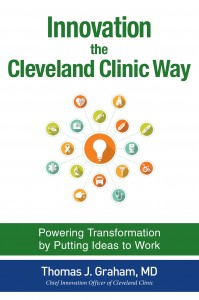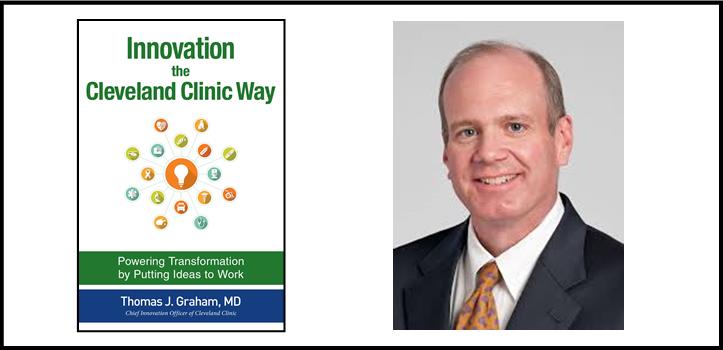“The answer is a resounding yes.” – Dr. Thomas Graham, author of Innovation the Cleveland Clinic Way: Powering Transformation by Putting Ideas to Work
Joe Dager: I think many people would challenge the notion that you could have a methodology for innovation. Do you feel like you have what you call a method or a repeatable process?
Dr. Thomas Graham: That’s a great question. I think I spend more of my time disabusing the concept and innovation now which is using common parlance. You turn on the TV, and you hear it regarding cars or other service industries. It’s innovation this, an innovation that. It’s both meaningless for a lot of people and maybe the most meaningful thing you could have. It’s not a creative wind that just blows through the organization, and you get to dress down on Fridays and throw a Frisbee in the hall and bring your dog to work. That’s not innovation; maybe that’s creativity. Innovation is putting ideas to work, taking a transcendent thought and reducing it to practice. 
For that reason, I would venture it is a practice. It’s a process-oriented, metrics driven engagement and that’s really maybe the secret sauce that started mission driven innovation Cleveland Clinic style. Mission driven, meaning everything we do, is to improve and extend the human life. The answer is a resounding yes and frankly, if there’s one thing that I would like people to take away from the book is we put our methodologies out there; they’re to be shared. This includes the proprietary technology scoring instruments that we use, the process we use to take a napkin idea through the important steps to finally deliver it to the marketplace, the way we approach investors, the way we work with governments and elected officials; I will tell you in no small way, this was meant to be a playbook. Innovation is not something where I’m aboard; I’m going to pull up the ladder. Innovation happens best at the intersection of knowledge domains, and we want people to know how to do it; we want people to know that we’re all open to collaboration, another critical component of successful innovation.
The answer is yes, and frankly, people might say, hey why did you give away your secret sauce? Because it’s not competitive. The worst thing that happens Joe is Dr. Jones has a great idea, and she’s seen a bunch of patients, and she’s seen an implant fail in the same place, and she says, I can fix that. I’m going to scribble it down on the back of a note card. If she doesn’t have some place to take that, who understands how to protect it, how to prototype it, how to move it through all these processes, how to raise capital around it, at the end of the day, no patient would be helped, the inventor wouldn’t benefit, no jobs would be created in her region. Whereas if it can upload into an already operational platform like Cleveland Clinic innovations developed, then all of a sudden, great things happen. It makes it back to her hand at the bedside, in the operating room, in the clinic. And all of a sudden, it does touch patients and not just the next patient she’s going to see but the patients all over the world, and that’s the multiplicative effect of innovation.
Thomas J. Graham, MD, was the Chief Innovation Officer of Cleveland Clinic and Vice Chairman of Orthopedic Surgery. A prolific inventor with nearly 50 worldwide patents and a serial entrepreneur, he is a renowned orthopaedic surgeon whose practice is the premier destination for the care of the professional athlete’s hand and wrist. He is regularly recognized as one of “America’s Best Doctors.”
Dr. Graham is next week’s guest on the Business901 podcast and this is one that I can assure you, you will not want to miss.

